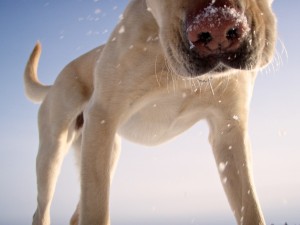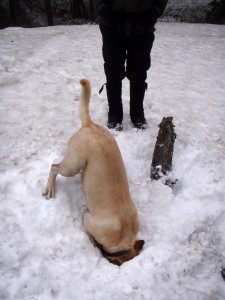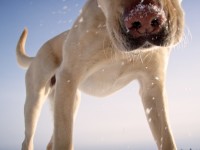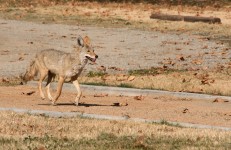Nose to the ground, tail whirling like a helicopter and a fast-paced trot on the verge of a run indicates that my canine companion is on the trail of a coyote while a more stiff-legged trot indicates snowshoe hares are nearby.
I enjoy seeing my dog sniff different animal trails (except when we have to stop at every clump of grass when on a leash) and it’s that incredible sense of smell that puts some dog’s noses to work. Dogs can be trained to smell for drugs, bombs, people, produce, cancer and even wood frogs (for research).
A dog’s amazing sense of smell is due to the large set of scent membranes in their nose. In humans, these olfactory receptors are the size of a pair of postage stamps while in dogs they can range from the size of a handkerchief to one square yard in large dogs such as German shepherds. Our olfactory receptors are located behind the bridge of our nose where glasses rest.
A dog’s nose works similar to a human nose. We inhale odor molecules that come into contact with mucus (snot does have a purpose) and dissolves. These dissolved odor molecules are then detected by the olfactory receptors and shuttled via chemical signals to the brain’s olfactory lobe.
Here, a dog’s brain creates an “odor image” similar to a photograph from visual signals from the eyes. This scent is imprinted into a dog’s brain, allowing it to follow that scent when trained or to remember that scent for future encounters, such as coyote scent.
The ability of dogs to follow the scent of criminals or missing persons is in part due to the trail left behind. Scent trails are created by ‘rafts’–tiny bits of skin cells that we shed at a rate of 50 million cells per day–and a combination of sweat and bacteria on those rafts. This microscopic confetti creates a trail unique to each individual because each person’s confetti has a distinct odor.
When we sniff we cannot smell the odor when exhaling. However, dogs have a bony shelf within their nasal cavity that creates a nasal pocket to keep the odor molecules in during exhalation. This allows for an accumulation of odor molecules and more of a chance for the molecules to interact with the olfactory receptors.
Dogs have 44 times more olfactory receptors than humans–220 million compared to five million–allowing even the faintest amount of odor molecules to be detected. The increased number of olfactory receptors along with more of the brain devoted to olfaction are the two main reasons dogs have more than one thousand times better sense of smell than humans.
When our canine companion’s nose is to the ground, the sensitive membranes behind the damp nostrils allow them to distinguish the scent of a coyote from a hare, pancakes and sausage on the breakfast table or the scent of neighborhood dogs on a clump of grass. The damp noses of certain dogs save the lives of people buried in avalanches and earthquake debris, help detect cancer or forewarn their owners of seizures because of their amazing sense of smell.






